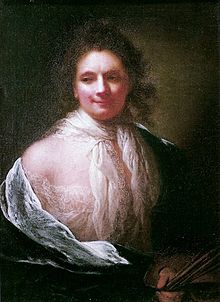Anna Dorothea Therbusch
| Anna Dorothea Therbusch | |
|---|---|

Anna Dorothea Therbusch
Self-portrait from 1761 |
|
| Born |
23 July 1721 Berlin, Kingdom of Prussia |
| Died | 9 November 1782 (aged 61) Berlin, Kingdom of Prussia |
| Other names | Lisiewski (maiden name) |
| Occupation | Painter |
Anna Dorothea Therbusch (born Anna Dorothea Lisiewski, Polish: Anna Dorota Lisiewska, 23 July 1721 – 9 November 1782) was a prominent Rococo painter born in the Kingdom of Prussia. About 200 of her works survive, and she painted at least eighty-five verified portraits.
Anna Dorothea Therbusch was born in Berlin. She came from a noted family, the daughter of Georg Lisiewski (1674–1751), a Berlin portrait painter of Polish stock who arrived in Prussia in 1692 as part of the retinue of the court architect Johann Friedrich Eosander von Göthe. Georg taught Anna, her sister and their brother to paint. Anna Dorothea and her elder sister Anna Rosina were hailed as Wunderkinder of painting.
Anna Dorothea married Berlin innkeeper Ernst Friedrich Therbusch and gave up painting until around 1760 in order to help her husband in the restaurant. Not until her spousal obligations were discharged, as a "short-sighted, middle-aged woman", did she abandon her family to return to her art.
She does not lack the talent to arouse interest in a country like ours, she lacks youth, beauty, modesty, coquetterie. She could have been enthusiastic about the merits of our great artists, taken lessons from them, had more bosom and a handsome posterior and have had to offer both to the artists.
Therbusch's first recorded return to painting was in 1761 in the Stuttgart court of Duke Karl Eugen. She completed eighteen paintings in the shortest time for the castle gallery. In 1762 she became an honorary member of the Stuttgart Academy of the Arts and worked in Stuttgart and Mannheim. In 1765 she went to Paris. The French Royal Academy of Painting and Sculpture displayed her work first, proudly supporting a female artist. Denis Diderot, the controversial and outspoken art critic and philosopher, was sympathetic to her, even to the point of posing naked for her. Anna Dorothea finally joined the Academy in 1767, lived with Diderot and met famous artists, and even painted Philipp Hackert but she remained unsuccessful in Paris. That time is, however, seen as her most creative.
...
Wikipedia
